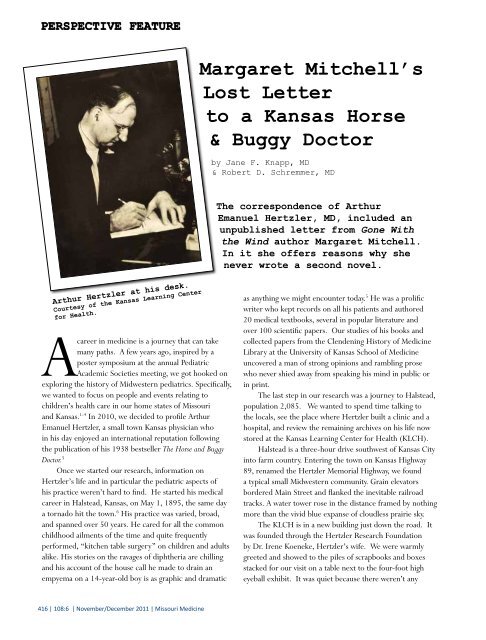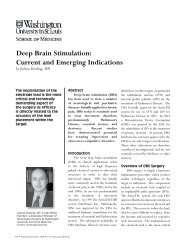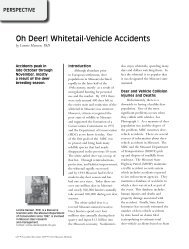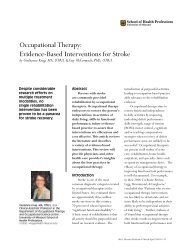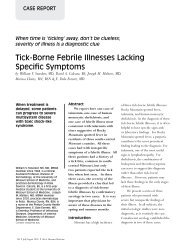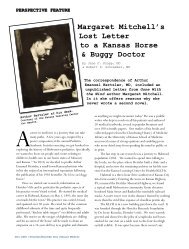Margaret Mitchell's Lost Letter from a Horse and Buggy Doctor
Margaret Mitchell's Lost Letter from a Horse and Buggy Doctor
Margaret Mitchell's Lost Letter from a Horse and Buggy Doctor
Create successful ePaper yourself
Turn your PDF publications into a flip-book with our unique Google optimized e-Paper software.
Perspective Featureschool tours that day; a perfect time for poring through oldrecords.It didn’t take long to discover the letter <strong>from</strong><strong>Margaret</strong> Mitchell on her personalized stationary datedSeptember 7, 1944. (See Figure 1, next page.) Our firstthoughts inevitably were, “The Gone With the Wind <strong>Margaret</strong>Mitchell?” It was soonapparent that it was indeedthe <strong>Margaret</strong> Mitchell,<strong>and</strong> that she was a fan asshe put it “of Hertzler’spungent writing style.”Based on our collectiveknowledge of Arthur’swriting, we easily related.The letter was obviously<strong>from</strong> one writer to another<strong>and</strong> typified her specialtalent as a storyteller.She began by referring toHertzler’s book Ventures inScience of a Country Surgeon. 7Toward the end of thebook, in a chapter entitled,“The Writing of Books,”he notes that he had beenintroduced to <strong>Margaret</strong>Mitchell, <strong>and</strong> described heras, “the most remarkableperson I have ever met.” 7The next to lastparagraph piqued ourcuriosity. In her letter, <strong>Margaret</strong> Mitchell tells ArthurHertzler why, as of 1944, she had not written anotherbook. On further reading we learned that biographershave well chronicled her father Eugene Mitchell’s ill health,protracted decline <strong>and</strong> <strong>Margaret</strong>’s immersion in his care.8, 9They have also recounted multiple other stressors,including her struggle to cope with the notoriety <strong>and</strong>complexities of her life following the publication of GoneWith the Wind, her own poor health, <strong>and</strong> her husb<strong>and</strong>’sfrailty. Interestingly, after her death in 1949 her husb<strong>and</strong><strong>and</strong> brother wrote to her correspondents requesting thatthey destroy her letters 9 but Arthur had died in 1946 soonafter retirement. That letter, tucked away in Kansas fordecades, provides the opportunity to revisit <strong>Margaret</strong>’sthoughts on writing again with the clarity <strong>and</strong> poignancy ofher own words. In a touch of irony she ended by urginghim to write more.<strong>Margaret</strong> Mitchell, circa 1941.Source: U.S. Library of Congress.The letter <strong>from</strong> <strong>Margaret</strong> Mitchell wasn’t the onlyfind. There was a copy of a letter <strong>from</strong> Albert Einsteindated June 24, 1944, in which he thanks Hertzler forsending him a copy of The Grounds of an Old SurgeonsFaith. 10 A retinue of the 1941 Chicago Cubs sent a letterautographed by players, coaches, the manager, trainer,<strong>and</strong> newspapermen thankinghim for the steaks he supplied totheir dining car during a train tripthrough Wichita. They also sentalong a thick packet of autographedindividual <strong>and</strong> group pictures;there’s a good one of Dizzy Dean.Fellow Kansan Karl Menninger senta letter congratulating Hertzleron his career achievements whenArthur retired in 1946. Theletters left us flush with the thrillof discovery, but also struck bythis sturdy <strong>and</strong> enduring formof communication much richerin composition than the hastilydeleted e-mails <strong>and</strong> superficial texts<strong>and</strong> tweets of today.Ultimately, the most rewardingpart of this journey into historywas the visit to Halstead. Forit was there that we gained anunderst<strong>and</strong>ing of Arthur Hertzler,the person behind the books.Before we left we viewed theglass display cases filled withmemorabilia in the back of themuseum. There among the old medical instruments was alarge leather bound copy of De Humani Corporis Fabrica LibriDecem the anatomy text by Adriani Spigelii (also known asAdriaan van den Spiegel), published in Venice in 1627. 11From signatures in the front of the book it appears to haveonce been owned by Franz Leydig. Hertzler was a seriousstudent of anatomy. In 1899, he took a two-year hiatus<strong>from</strong> his practice to study anatomy <strong>and</strong> surgical pathologywith Virchow <strong>and</strong> Waldeyer in Berlin. In the <strong>Horse</strong> <strong>and</strong><strong>Buggy</strong> <strong>Doctor</strong> he writes of his great respect for his teachers<strong>and</strong> notes that, “no American teacher ever showed me themany favors that many of these German professors did.”5We saw the picture of his beloved daughter, Agnes, theblack-eyed girl that he refers to several times in The <strong>Horse</strong><strong>and</strong> <strong>Buggy</strong> <strong>Doctor</strong>. Agnes, we learned through personalcommunication with KLCH staff, died at 18 during anappendectomy being performed by her father. The story ofMissouri Medicine | November/December 2011 | 108:6 | 417
<strong>Margaret</strong> MitchellAtlanta, GeorgiaSeptember, 1944Dear <strong>Doctor</strong> Hertzler:Last night I began picking about in “Ventures in Science of a Country Surgeon,” for Ihave the bad habit of never starting a book at the beginning <strong>and</strong> reading it to the end. Asa child I was reproved for picking all the raisins out of puddings <strong>and</strong> eating them first, <strong>and</strong>I have not improved much since then. After eating the raisins I always ate all the pudding,too, so I could never underst<strong>and</strong> why my practice was reprehensible. While putting in myfingers to pull out a medical raisin, whom should I find but myself. To say I was surprised isa very great understatement. To say I was pleased <strong>and</strong> flattered at what you said is such anunderstatement I scarcely have the courage to put it down. I ate this raisin immediately <strong>and</strong>enjoyed it very much <strong>and</strong> thank you so much for your forthright remark.I not only get information <strong>from</strong> your medical books but I get vast entertainment. Ido not know anyone who writes as pungently as you do. Nor do I know anyone who can use ameat exe on the pompous or the misguided or the overstuffed with such deadly aim. I know Ishould not get so much pleasure <strong>and</strong> laughter <strong>from</strong> books as serious as yours, but I do <strong>and</strong> mustconfess it. I think you must be an extraordinarily able teacher with never a dull moment inyour classes, for you have a vigorous mind <strong>and</strong> you certainly speak it.I had enjoyed Chronic Appendicitis enormously, for I have the rare good luck of havingan old fashioned doctor for a friend <strong>and</strong> I have heard him express himself in similar termson this same subject. I read parts of it to my husb<strong>and</strong>, who listened with interest equal tomine. Then, picking about in the section, Ventures in Therapeutics, my eyes fell upon thewords “sciatica <strong>and</strong> compressed nerves.” I read this section aloud, too, <strong>and</strong> I cannot tell youhow enchanted my husb<strong>and</strong> <strong>and</strong> I were by what you wrote. I would like to say that I “rolledon the floor” at your remarks about the specialists <strong>and</strong> their work upon the spine, but, dear<strong>Doctor</strong>, I do not roll on the floor these days, nor roll anywhere, because I am one of thosepeople who had my intervertebral disks worked on eighteen months ago <strong>and</strong> am in far worse shapethan before. However, I suppose that I am mentally in fine condition, for I can laugh aboutthis section of your book when too deep a laugh is not very pleasant. The doctor who yankedout my disk is inviting me back to the hospital to do the operation over, <strong>and</strong> when he issueshis next invite I think I’ll quote him, line <strong>and</strong> page, <strong>from</strong> your book. After I had read myhusb<strong>and</strong> the part about you <strong>and</strong> the hash <strong>and</strong> the stomach pump <strong>and</strong> the cardia, he had to takeoff his glasses <strong>and</strong> wipe them because he had laughed till he had cried. He said that you mustbe one of the most remarkable people in shoe leather to be able to make your point about thestrength of these muscles with such vividness. “The <strong>Doctor</strong> is a salty cuss,” he said, “<strong>and</strong> youcertainly were lucky to meet him. I only wish I had the chance to know him myself.”I did not write you after I had read your book on the “Diseases of the Thyroid Gl<strong>and</strong>,”but it was not through lack of interest. I read it slowly <strong>and</strong> with care, harassing the oldfashioned friend I mentioned above for meanings of medical terms <strong>and</strong> explanations of surgicaltechnique which no layman can know. That is an impressive volume, impressive especially whenI think of the many years’ study <strong>and</strong> thought which went into making it. If you had no othermonument except this it would be a greater monument than most men can ever hope for, but hereyou go along writing other books just as good!I had intended to write you about the thyroid book, but my father died in June <strong>and</strong>I did not have time or the heart. He had been ill so long---six years in all, <strong>and</strong> the lastthree in the hospital. He would not have a kidney stone removed many years ago when he wasin excellent health <strong>and</strong> he delayed far too long in having a prostatic operation. Three yearsago we did not expect him to live another week, <strong>and</strong> for his sake I wish it had been that way.He had the constitution of an ox <strong>and</strong> just how he stayed alive his doctors did not know. I’msure you’ve seen uremia <strong>and</strong> abscessed kidneys <strong>and</strong> toxemia <strong>and</strong> pneumonia enough so that I donot have to tell you what those years were. When people ask why I have not written anotherbook, I look at them in wonder, for how can one do creative work in a constant worry like thisor when physical fatigue reaches the point of exhaustion every day. I hope that my own healthwill improve now that I do not have to bend over high hospital beds or fix pillows or lift orstrain. I’ve had it on my mind so often to thank you for that book, for I really got a lot outof it.You do not fool me at all <strong>and</strong> I do not think you are fooling yourself by your statementin the front of your “Ventures”---“this is probably my last book.” I know there’ll be plentyof others.Cordially,
her tragic death supplied the heretofore missingperspective into Arthur’s pungent writing style.It also provided us insight into the personal lossthat we now understood, <strong>from</strong> other papers weexamined at the KLCH, haunted him throughouthis life.Our poster on The Life <strong>and</strong> Times of a Kansas<strong>Horse</strong> <strong>and</strong> <strong>Buggy</strong> <strong>Doctor</strong> <strong>and</strong> His Recollections onthe Care of Children was presented at the 2011Pediatric Academic Societies Meeting. 12 Itfocused on Arthur’s professional career as aphysician on the Kansas prairie in a time whenit took stamina <strong>and</strong> grit to reach your patients<strong>and</strong> skill, experience <strong>and</strong> ingenuity once yougot there. It recounted stories of his care forchildren whom he said, “always came first.” 5But, our poster didn’t tell the less public storywe found preserved in the letters, scrapbooks,displays <strong>and</strong> oral history of Halstead. It seemed ashame not to share it.References1. Schremmer RD, Knapp JF. Herbert A. Wenner, Polio, <strong>and</strong> theFort Knox of Virology. (abstract) EPAS2008:3220.8.2. Schremmer RD, Knapp JF, Hellerstein S. Dan Darrow: TheKansas City Years. (abstract) EPAS2009:2145.13.3. Schremmer RD, Knapp JF. Give ‘Em Healthcare Harry:It Started with the Man <strong>from</strong> Independence. (abstract)EPAS2010:1352.5.4. Schremmer RD, Knapp JF. Harry Truman <strong>and</strong> health carereform: the debated started here. Pediatrics 2011; 98:497-499.5. Hertzler AE. The <strong>Horse</strong> <strong>and</strong> <strong>Buggy</strong> <strong>Doctor</strong>. 1st ed. New York, NY: Harper & Brothers: 1938.6. Hertzler JJ. Arthur E. Hertzler the Kansas horse <strong>and</strong> buggy doctor: a biographical sketch.Journal of the Kansas Medical Society 1962; 63(10):424-433.7. Hertzler AE. Ventures in Science of a Country Surgeon. Halstead, KS: published bythe author: 1944.8. Pyron DA. Southern Daughter: The Life of <strong>Margaret</strong> Mitchell. New York: OxfordUniversity Press: 1991.9. Edwards A. Road to Tara: The Life of <strong>Margaret</strong> Mitchell. New Haven, Conn: Ticknor<strong>and</strong> Fields: 1983.10. Hertzler AE. The Grounds of an Old Surgeons Faith. Wichita, KS: Wichita Eagle Press: 1944.11. Spigelii A. De Humani Corporis Fabrica Libri Decem. Venice: Evangelista Deuchino: 1627.12. Schremmer RD, Knapp JF. The Life <strong>and</strong> Times of a Kansas <strong>Horse</strong> <strong>and</strong> <strong>Buggy</strong> <strong>Doctor</strong> <strong>and</strong> HisRecollections on the Care of Children. (abstract) EPAS2011:1160.5AcknowledgmentThe authors would like to acknowledge the assistance of BrendaSooter, Executive Director, the staff <strong>and</strong> the Board of Directors of theKansas Learning Center for Health for their assistance in our research<strong>and</strong> the preparation of this manuscript, <strong>and</strong> www.halsteadks.com.Figure 1 (opposite page)Scanned copy of <strong>Margaret</strong> Mitchell’s letter toAuthor Hertzler. Courtesy of the Kansas Learning Centerfor Health. Recreated for Missouri Medicine.Hertzler Memorial Highway sign on the outskirtsof Halstead, KS. Photo by R. Schremmer, MD.Jane F. Knapp, MD, MSMAmember since 1989, is Chairor the Department of MedicalEducation <strong>and</strong> Associate Chairof Pediatrics at Children’sMercy Hospitals <strong>and</strong> Clinicsin Kansas City, <strong>and</strong> AssociateDean at the University ofMissouri-Kansas City Schoolof Medicine. Robert D.Schremmer, MD, is AssociateProfessor of Pediatrics inthe Division of EmergencyMedicine <strong>and</strong> Urgent CareServices at UMKC.Contact: jknapp@cmh.eduMMMissouri Medicine | November/December 2011 | 108:6 | 419


